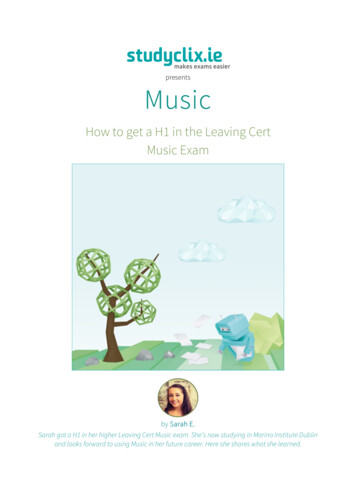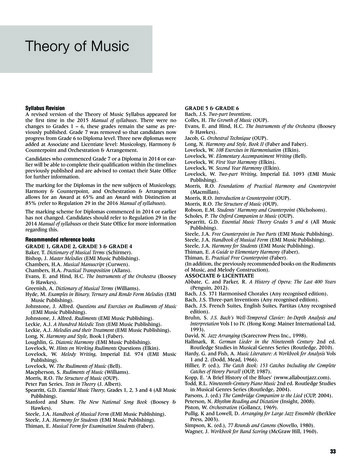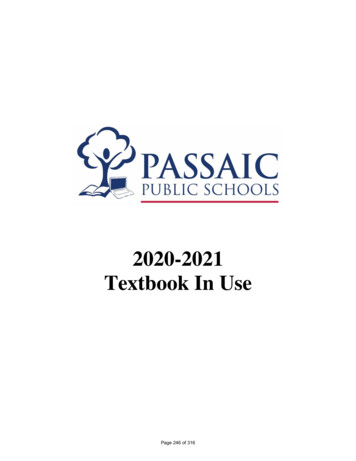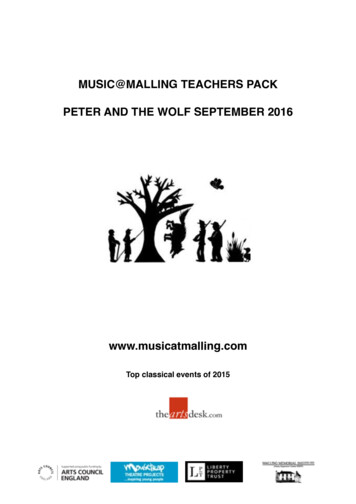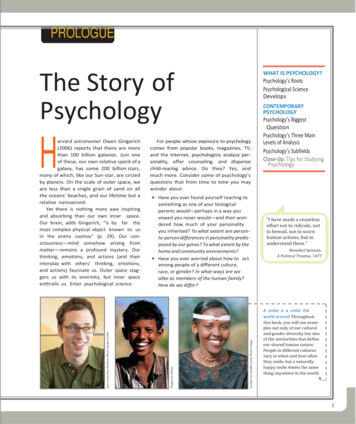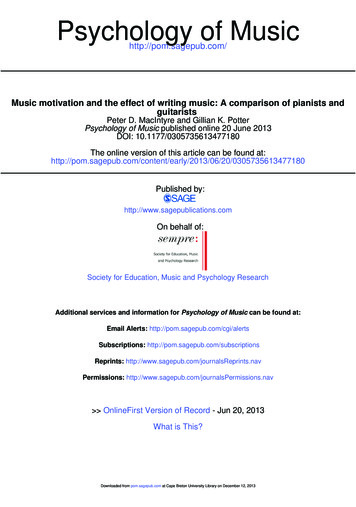
Transcription
Psychology of Musichttp://pom.sagepub.com/Music motivation and the effect of writing music: A comparison of pianists andguitaristsPeter D. MacIntyre and Gillian K. PotterPsychology of Music published online 20 June 2013DOI: 10.1177/0305735613477180The online version of this article can be found /0305735613477180Published by:http://www.sagepublications.comOn behalf of:Society for Education, Music and Psychology ResearchAdditional services and information for Psychology of Music can be found at:Email Alerts: http://pom.sagepub.com/cgi/alertsSubscriptions: http://pom.sagepub.com/subscriptionsReprints: ions: http://www.sagepub.com/journalsPermissions.nav OnlineFirst Version of Record - Jun 20, 2013What is This?Downloaded from pom.sagepub.com at Cape Breton University Library on December 12, 2013
4771802013POM0010.1177/0305735613477180Psychology of MusicMacIntyre and PotterArticleMusic motivation and the effectof writing music: A comparisonof pianists and guitaristsPsychology of Music0(0) 1 –17 The Author(s) 2013Reprints and OI: 10.1177/0305735613477180pom.sagepub.comPeter D. MacIntyre and Gillian K. PotterCape Breton University, CanadaAbstractThe purpose of this study is to examine a set of motivation variables within guitar and pianoplayers. We also tested for motivational differences among three groups: those who write music,those who plan to write music in the future, and those who do not write nor intend to write. Aninternational sample of 599 musicians was obtained (guitar: N 292, piano: N 307) throughthe use of an online survey. Self-Determination Theory, a prominent perspective in the motivationliterature, was utilized along with other motivational constructs, including perceived competence,musical self-esteem, effort, desire to learn, willingness to play, and possible musical selves. Findingsrevealed differences between pianists’ and guitarists’ levels of motivational intensity, desire to learn,introjected regulation, perceived competence and willingness to play. Results also indicated that thegroup who write music had significantly higher levels of musical self-esteem, willingness to play,motivational intensity, desire to learn, and perceived competence. Findings from this study suggestthat pianists and guitarists both are intrinsically motivated, but for different reasons. The underlyingmotivational needs that are met by the instrument’s “culture” appear to focus on competence forpianists and on autonomy and relatedness for guitarists.Keywordsautonomy, competence, intrinsic, motivation, musical self, relatedness, self-determination, writing musicTo play a musical instrument well requires an extensive amount of effort and a potentially significant investment of oneself in the music learning and creation process. The intensity andduration of the learning process implies a strong role for sustaining motivation in the successof a musician. This study will examine musicians who play two of the most popular instruments, piano and guitar, with the goal of identifying similarities and differences between themin key motivation variables, and whether or not the creative process of writing music is relatedto musicians’ motivation.Corresponding author:Peter D. MacIntyre, Psychology Department, Cape Breton University, 1250 Grand Lake Road, Sydney, Nova Scotia,Canada B1P 6L2.Email: peter macintyre@cbu.caDownloaded from pom.sagepub.com at Cape Breton University Library on December 12, 2013
2Psychology of Music 0(0)Perhaps the most obvious difference among musicians is their choice of instrument. A musical instrument can be much more than a stand-alone physical object in the eyes of the one whoplays it; the instrument can become part of the person’s identity, an extension of the self.When we think of a musician’s virtuosity or even of her expressiveness or musicality, we think of thesethings as specifically tied up with what she does with the particular instrument she plays . . . (T)hetruth is that it is difficult to say where the instrument ends and the rest of the body begins. (Alperson,2008, pp. 37–40)The preference for a particular musical instrument has been found to be related in part tothe musician’s personality (Bell & Cresswell, 1984; Cribb & Gregory, 1999). Other studies suggest that one’s masculinity or femininity, a key element of identity, can be enhanced or challenged by the choice of a particular instrument (Delzell & Leppla, 1992; O’Neill & Boulton,1996; Sinzel, Dixon, & Blades-Zeller, 1997). The qualities of the instrument, how it can beused, and the ways in which one learns to play are relevant to how a musician is perceived.Both piano and guitar can be played across musical genres, either as part of a group or a singleinstrument performance, and are often played alone for personal enjoyment. Piano tends to belearned and practiced more formally than guitar (Daniel, 2004; Green, 2006). Learning to playthe piano tends to emphasize attention to technique, theory, and reading music. Learning toplay guitar lends itself to noodling, improvisation and “jamming.” Cribb and Gregory (1999)argue that each instrument is associated with a specific culture. This is not to say that everypianist or guitarist learns in the same way, but as large groups, we can observe regular patternsin how the instruments are approached. If the cultures of the instruments show differences,and the motivational dynamics of the people who play them can be affected by these patterns,then it seems plausible that the piano will motivate its musicians in ways that differ from theguitar. Our first goal is to examine the relationship among key motivation variables for pianistsand guitarists.1Our second goal is to examine motivational differences associated with writing music. A musical piece often is seen as an extension of the person who wrote it. Even simple compositions aresaturated with the author’s experiences, interpretations, thoughts and emotions – all significantcomponents of personal identity. Simply engaging in the writing process, or setting a goal to oneday be a writer, can be a window into the self and its motivations. Song writing has been reportedto be therapeutic for individuals suffering from anorexia nervosa (McFerran, Baker, Patton, &Sawyer, 2006), palliative care patients (O’Callaghan, 1996), and troubled teens (Keen, 2004).The Victorian author Samuel Butler wrote, “Every man’s work, whether it be literature or musicor pictures or architecture or anything else, is always a portrait of himself.” The act of writingmusic can lead to powerful forms of self-expression that become integral to a sense of identity. Inhis blog “Creating Music,” Jason Hannah (2010) asked fellow musicians why they write or createmusic. In summing up the contributions he received, Hannah (2010) suggested a consensus: “Icreate music because that’s who I am . . . a songwriter, a musician, and a creative artist.” Given itsintegral role in self-perceptions, the act of composing music seems likely to affect musical motivation (Leung, 2008). Additional research is needed to understand the motivational implications ofwriting music, and whether pianists and guitarists are equally likely to write.Perspectives on motivationThe present study sampled concepts from the broad literature on motivation in order to betterunderstand similarities and differences between pianists and guitarists. Arguably, the keyDownloaded from pom.sagepub.com at Cape Breton University Library on December 12, 2013
3MacIntyre and Potterdistinction in the current modern motivation literature is between intrinsic and extrinsicmotives, but it would be too simplistic to believe that pianists and guitarists are either intrinsically or extrinsically motivated. Rather, intrinsic and extrinsic motives are treated as part of acontinuum within Self-Determination Theory (SDT, Deci & Ryan, 1985). SDT highlights theindividual’s sense of self and the satisfaction of needs for competence, relatedness and autonomy as fundamental to an understanding of motivation. To shed light on other aspects of theself, we will also measure self-esteem as well as possible musical selves.The musical self: Self-Determination Theory. SDT considers motivation a multifaceted phenomenon that highlights differences in types or qualities of motivation (Deci & Ryan, 1985, 2002,2008; Ryan & Deci, 2000). To differentiate intrinsic from extrinsic motives, Deci and Ryan(2008) focus on the degree to which motives are self-directed and autonomous versus otherdirected and externally controlled. Four key concepts can be identified and located on a continuum. (1) Intrinsic regulation is the most autonomous type of motivation. It arises from aninherent interest and sense of gratification from the activity itself, such as playing an instrument simply for the joy it provides. (2) Identified regulation arises from personal values and asense of importance or meaning that an activity provides, and is somewhat less autonomousthan intrinsic regulation. Identified regulation can motivate behavior required by a specificrole or sense of self that might not be inherently enjoyable (e.g., “I practice because I am apianist, and a pianist must practice”). (3) Introjected regulation is energized by factors such asan approval motive, avoidance of shame, contingent self-esteem, and ego-involvement. Fallingtoward the controlled end of the continuum, introjected regulation involves feelings of obligation or doing something because one “ought to” do it. The most controlling type of motivation,(4) Extrinsic regulation, supports behaviors performed to obtain a tangible reward or to satisfyan external demand, as when one performs for money or to pass an examination. Previousresearch on this theory has provided support for its key theoretical tenets (Deci & Ryan, 1985,2002, 2008; Ryan & Deci, 2000).The theoretical underpinnings of SDT propose that three basic, psychological needs underlie the intrinsic-extrinsic continuum: competence, autonomy, and relatedness (Deci & Ryan,2008). Competence reflects the psychological need to be effective in interactions with the environment, the desire to exercise one’s capacities and skills and, in doing so, to seek out andmaster optimal challenges (Deci & Ryan, 1985). The second need, autonomy, reflects the psychological need to experience self-direction and personal endorsement in the initiation andregulation of one’s behavior (Deci & Ryan, 1985); to be an “origin” rather than a “pawn.”Finally, relatedness is the psychological need to establish close emotional bonds and attachments with other people and is accompanied by a desire for intimacy (Deci & Ryan, 2008;Ryan, 1991). SDT represents a potentially powerful scheme for understanding music motivation and its roots.Possible musical selves. If SDT is a reflection of the present motivated self, possible selves theoryapproaches motivation from a teleological perspective (Markus and Nurius, 1986). Possibleselves are cognitive-affective manifestations of one’s self in the future (Markus & Nurius, 1986)in various life domains, including music (Schnare, MacIntyre & Doucette, 2011), and reflect anawareness of one’s potential (Oyserman & Markus, 1990). More specifically, possible selvesreflect individuals’ ideas about what they would like to become and what they are afraid tobecome in the future (Markus & Nurius, 1986; Markus & Ruvolo, 1989). The desired and/orundesired imagined future self acts as either an attractive incentive to be approached or anunattractive incentive to be avoided (Markus & Nurius, 1986). A child may form a possibleDownloaded from pom.sagepub.com at Cape Breton University Library on December 12, 2013
4Psychology of Music 0(0)musical self by observing an admired musical role model, perhaps a rock star guitarist or a brilliant classical pianist. Forming a possible self includes creating a mental image of playing for anadoring audience, along with anticipating the events, sensations and reactions of both self andothers (Erikson, 2007). This rich source of imagery taps into a potentially deep well-spring ofemotion and motivation by integrating attributes that the self does not yet possess into a desiredgoal (Schnare et al., 2011).Musical self-esteem. In conjunction with the description of possible selves, this study also examined self-esteem in the music domain. Self-esteem reflects a generally favorable or unfavorableattitude toward the self (Rosenberg, 1965), with perceived achievement being the key influence on levels of self-esteem (Marsh, Trautwein, Ludke, Koller, & Baumert, 2006). Self-esteemis linked to motivation by reflecting the quality of adaptive and productive functioning (Josephs,Markus, & Tafarodi, 1992).Desire to learn and motivational intensity (effort). MacIntyre, Potter and Burns (2012) found thatmotivation for music learning, defined in large part by the desire to learn and motivational intensity (effort), strongly predicted both practice and the perception of musical competence. Desireto learn reflects the strength of the emotional attachment the student has towards learning.Motivational intensity reflects the level of effort that a student is willing to put forth (see Gardner, 1985).Willingness to play. This motivational construct has been adapted from McCroskey and Richmond’s (1991) Willingness to communicate which characterizes the readiness to initiate conversation if the opportunity arises. Music can be played meaningfully in performance settingsranging from highly formal recitals to informal jam sessions, and the volitional engagement inmusic performance helps to complete the motivational picture. If music performance is a formof self-expression or communication, then it might be helpful to examine the musician’s willingness to play across various settings.Motivation in contextResearch into music motivation has tended to focus on music learned and played within aschool setting (for example, Asmus, 1986; McCormick & McPherson, 2003; Schmidt, Zdzinski,& Ballard, 2006; Sichivista, 2007). Recent research by Green and others has examined motivation for music learned and played outside of an educational context and the findings point tointeresting contextual differences (see Cope, 2002; Green, 2006, 2008, 2009). Jaffurs (2006)suggested that institutionalized study tends to be accompanied by a degree of technical polishand refinement uncharacteristic of learning outside a school setting. In general, interest inmusic outside school appears to be much higher than music interest within a middle and highschool context (McPherson, 2010). The formal curriculum of music instruction might workagainst creating a sense of autonomy and is a constant challenge to feelings of competence asincipient skills develop (Bowman, 2004). Green (2004) suggested that, ironically, learningmusic in a formal setting does not appear to promote an integration of music into people’s dailylives.The differences between formal and informal musical contexts also are reflected in therelative emphasis placed on writing music. Composing often is an autonomous process andprovides an outlet for creativity and emotional expression. If formal instructionDownloaded from pom.sagepub.com at Cape Breton University Library on December 12, 2013
5MacIntyre and Potterplaces relatively less emphasis on writing music due to constraints imposed by teachers anda curriculum, then will pianists and guitarists differ on average in their desire to writemusic? If so, will writing music also be related to the other motivational variables discussedabove?The current studyThe present study examined pianists and guitarists outside a school environment, specifically asample of musicians recruited online. Our aim was to examine the correlations among themotivation variables described above that arise within a group of musicians who have diverselearning histories. In particular, we will test for differences between pianists and guitarists onthese motivational variables. Finally, we examined whether or not writing music might berelated to the set of motivational variables in this study. Five specific research questions guidedthe analyses:RQ1: Will pianists and guitarists show different mean scores on the motivation variables?RQ2: How strongly do the motivational variables correlate with each other?RQ3: Will the magnitude of correlations among the motivational variables differ significantly for pianists and guitarists?RQ4: Do groups of musicians who write music, plan to do so, or have no intention to writemusic show different levels of motivational variables?RQ5: Are pianists and guitarists equally likely to write music?MethodParticipantsThis study consisted of 599 male (72%) and female (27%) musicians (guitar: N 292, piano:N 307). Musicians in the sample included both professionals and recreational players withformal and informal training backgrounds. Half of the guitarists claimed to be primarily selftaught and another 8% learned from friends and family, only 16% of guitarists had 2 or moreyears of formal musical training. More than two-thirds of pianists (69%) had 2 or more yearsof formal training and another 15% undertook formal training for less than 2 years. The musicians were distributed across a range of ages as follows: under 20 years (17.9%), in their 20s(17.5%), in their 30s (16.7%), in their 40s (19.2), in their 50s (18.9%) and over 60 years of age(9.5%). Over a third of the sample (33.4%) began learning their instrument before the age of10 and another 41.2% began learning in their teenage years. The international sample wascomprised of participants from 57 countries, including the US (n 326), the UK (n 93),Canada (n 64), Australia (n 16) and Germany (n 12). The most popular genres of musicplayed by the respondents, based on the categories used for the Recording Industry Associationof America’s Grammy Awards, were classical and pop for pianists, rock and blues for guitarists(see Table 1).Materials/measuresIn addition to demographic information, the following scales2 were included in the onlinequestionnaire:Downloaded from pom.sagepub.com at Cape Breton University Library on December 12, 2013
6Psychology of Music 0(0)Table 1. Top 10 genres of music played by respondents.1.2.3.4.5.6.7.8.9.10.Total number of genresreportedPiano genre (number*)Guitar genre (number*)Classical (167)Pop & Traditional pop (130)Jazz (71)Gospel (70)Blues (63)Rock (55)Folk (52)New Age (55)Children’s (42)Alternative (37)1018Rock (219)Blues (185)Pop & Traditional pop (176)Alternative (128)Country (122)Folk (113)Jazz (100)Metal (87)R&B (80)Classical (69)1718Note. *The number in parentheses reflects the number of respondents who listed the genre as one they play. Respondents could list as many genres as they wished.Self-determination. Participants completed 16 items from Williams and Deci’s (1996) Self-Determination Scale, which measured individual differences in quality of motivation (extrinsic regulation, α .79 piano and .73 guitar, introjected regulation, α .76 piano and α .82 guitar,identified regulation, α .72 piano and .61 guitar, and intrinsic regulation, α .65 piano and.63 guitar). A 7-point Likert scale was used that ranged from 1 (not at all true) to 7 (very true).An example item measuring extrinsic regulation was as follows: “Because I feel like I have nochoice about playing music; others make me do it.”Perceived competence. This variable was measured by adapting 4 items from Williams and Deci(1996). An example item read as follows: “I feel confident in my ability to learn music.” A7-point Likert scale was used that ranged from 1 (not at all true) to 7 (very true). Reliability forthis scale was .85 for piano and .84 for guitar.Musical self-esteem. Rosenberg’s (1989) 10-item Self-Esteem Scale was adapted to measure Musical Self-Esteem. A 9-point Likert scale was used that ranged from 1 (very strongly disagree) to 9(very strongly agree). An example item from this scale read as follows: “In music, I feel that I ama person of worth, at least on an equal plane with others.” Reliability for this scale was .87 forpiano and .88 for guitar.Motivational intensity. This variable was extracted from Gardner and MacIntyre’s (1991) Attitudeand Motivation Test Battery (AMTB) and was adapted to music. Nine items were included in thisscale. A 7-point Likert scale was used that ranged from 1 (strongly disagree) to 7 (stronglyagree). An example item read as follows: “I really work hard to learn music.” Reliability for thisscale was .66 for piano and .62 for guitar.Desire to learn. This variable was taken from Gardner and MacIntyre’s (1991) Attitude and Motivation Test Battery (AMTB) and was adapted to music. Ten items were included on this scale. ADownloaded from pom.sagepub.com at Cape Breton University Library on December 12, 2013
7MacIntyre and Potter7-point Likert scale was used that ranged from 1 (strongly disagree) to 7 (strongly agree). Anexample item was as follows: “I want to learn music so well that it will become second nature tome.” Reliability for this scale was .70 for piano and .70 for guitar.Willingness to play. McCroskey and Baer’s (1985) 9-item Willingness to Communicate scale wasadapted to music, to measure Willingness to Play in formal, informal, and neutral settings infront of others. A 10-point Likert scale was used that ranged from 1 (I would never feel like playing) to 10 (I would always feel like playing). An example item was as follows: “When playingformally for a large group of strangers.” Reliability for this scale was .95 for piano and .94 forguitar.Possible selves. In order to introduce a qualitative dimension to this study to inform the interpretation of the quantitative results, three open-ended questions examined possible selves (seeSchnare et al., 2011): Hoped for Selves, Expected Selves, and Feared Selves. The questions read asfollows:Many people have in mind some things that they hope to be in the future, regardless of how likely it isthat they will actually be that way or do those things. We call these hoped-for selves. People considernot only what they want to happen, but also what they believe will happen to them. We call theseexpected selves. Finally, people also think of what they don’t want to happen to them, in other words,what they fear will happen. We call these feared selves. We are interested in these three types of possible selves in music.A. Please list below three possible musical selves that you would hope to describe you in thenext year. When I think about Music, next year I hope to be B. Please list below three possible musical selves that are most likely to be true of you in thenext year. When I think about Music, next year I expect to be C. Please list below three possible musical selves that you fear or worry about being in the nextyear. When I think about Music, next year I am afraid that I will be Selected quotes from the qualitative analysis of possible selves will be reported in the Discussionsection.ProcedureParticipants were recruited through snowball sampling, in which a link to an online survey(hosted by Google Docs) was posted to numerous music websites, chat forums, and Facebookgroups dedicated to discussion of piano and guitar. Participants were initially sent to an onlineconsent form describing the purpose and objective of the study. Participants were assured thatdata would be kept confidential and that they were free to choose not to answer any questionand to withdraw from the study at any time. Also included in this consent form was the contactinformation of the researchers and the University Research Ethics Committee. Participantsthen completed the demographics section followed by sections on motivational intensity, desireto learn, willingness to play, self-determination, perceived competence, and musical self-esteem.Finally, participants completed three open-ended questions, hoped for, expected, and fearedpossible selves.3Downloaded from pom.sagepub.com at Cape Breton University Library on December 12, 2013
8Psychology of Music 0(0)ResultsSignificant differences between pianists and guitarists were found among the means of themotivational variables. Using a one-way MANOVA (RQ1), a significant effect of instrument wasfound at the multivariate level F(9, 565) 14.8, p .001, partial η2 .19. At the univariatelevel, compared with guitarists, pianists showed significantly higher motivational intensity(F(1, 573) 25.8, p .001, partial η2 .04), desire to learn (F(1, 573) 5.30, p .05, partialη2 .01), and introjected regulation (F(1, 573) 4.13, p .05, partial η2 .007) but significantly lower perceived competence (F(1, 573) 7.84, p .05, partial η2 .014) and willingness to play (F(1, 573) 58.08, p .05, partial η2 .09). The remaining four variables,extrinsic regulation, identified regulation, intrinsic regulation, and musical self-esteem did notshow significant differences between groups (all Fs 0.65, ps .42). Means and standard deviations are presented in Table 2.Correlations were computed to examine how the variables fit together. Given that the meansfor five motivational variables differed significantly between the two groups, correlations will bereported separately for pianists and guitarists. To examine the relationships among the ninemotivation variables (RQ2), correlations were computed separately for pianists and guitarists(see Table 3). The four SDT variables (extrinsic, introjected, identified, and intrinsic regulation)showed the expected pattern of correlation; each variable was most strongly correlated with itsneighbor on the continuum. Intrinsic regulation was significantly correlated with all five of thenon-SDT variables (desire to learn, perceived competence, motivational intensity, musical selfesteem, and willingness to play). Identified regulation was correlated with three non-SDT variables: desire to learn, perceived competence, and motivational intensity. However, both extrinsicand introjected regulation correlated very weakly with the five non-SDT variables, and amongguitarists extrinsic regulation was significantly, negatively correlated with intrinsic regulation,perceived competence, desire to learn, and motivational intensity. In both groups, introjectedregulation was significantly, negatively correlated with musical self-esteem.Other especially noteworthy relationships include the strong inter-correlations amongperceived competence, willingness to play, and musical self-esteem (rs range from .46 to .71,ps .001). Further, for both pianists and guitarists, motivational intensity was stronglycorrelated (rs .50) with desire to learn and also with perceived competence (rs .33).Table 2. Means for pianists and guitarists on motivation variables.Extrinsic regulation*Introjected regulationIdentified regulationIntrinsic regulation*Perceived competence*Motivational intensity*Desire to learn*Willingness to play*Musical self-esteemGuitaristsPianists5.82 (3.29)12.87 (6.94)24.12 (3.67)22.66 (2.83)22.38 (4.78)46.92 (7.92)49.19 (5.96)68.21 (18.41)63.21 (15.11)5.86 (3.60)13.98 (6.22)24.37 (3.84)22.75 (2.74)21.22 (5.16)50.30 (8.04)50.30 (5.58)55.17 (22.38)62.60 (15.41)Note. * The difference between pianists and guitarists is significant (p .05). Standard deviations appear in parenthesis.Given the listwise deletion of cases with a missing value on any scale item, the sample size for this analysis was 283 forguitarists and 292 for pianists.Downloaded from pom.sagepub.com at Cape Breton University Library on December 12, 2013
9MacIntyre and PotterTable 3. Correlations among motivational constructs for pianists and guitarists.21. Intrinsic3P .69*** .22***G .65*** .072. IdentifiedP –.34***G.30***3. IntrojectedP–G4. ExtrinsicPG5. Perceived competence PG6. Musical self-esteemPG7. Desire to learnPG8. Motivational intensity PG9. Willingness to playPG456789 .05.26*** .21*** .43***,# .43*** .20*** .19**.35*** .14*.63***,# .50*** .19*** .01.22*** .12*.53***.41*** .24*** .07.28*** .01.63***.51*** .10.39*** .08 .32*** .19**.09 .01.37*** .08 .24*** .13*.06.06–.10.03-.08.00.07 .12* .08 .21*** .14.08–.71*** .13*.42*** .47***.68*** .29***.33*** .52***–.07.38*** .46***.11.19*** .49***–.50*** .17**.55*** .21***–.35***.18**–Note. * p .05; ** p .01; *** p .001; # correlations in this cell differ significantly (p .05).Abbreviations: P Pianists; G Guitarists.A z-test was used to examine differences in the magnitude of the observed correlationsbetween pianists and guitarists (RQ3). There were 36 pairs of correlations compared. To bemoderately conservative in evaluating the differences between correlations for pianists andguitarists, the Hochberg (1988) adjustment procedure was employed. This procedure adjuststhe alpha level in an ordered fashion, such that the smallest difference in correlations is evaluated at .05, the next smallest at .05/2 (.025), the next smallest at .05/3 (.017) and the largestdifference among the 36 pairs of correlations in Table 3 is evaluated at (.05/36 .0014). Onlyone pair of correlations produced a significant difference; the desire to learn was more stronglycorrelated with intrinsic motivation for pianists (r .63) than for guitarists (r .43) (z 3.43,p .001).The fourth and fifth research questions involved musical composition. To examine the potential relationship between writing music and the motivation variables, a one-way MANOVA wasperformed (RQ4). Three groups were identified, those who currently write music (n 272),those who do not write now but plan to write in the future (n 145), and those who neitherwrite nor plan to write (n 153). The three groups differed significantly at the multivariatelevel (F(18, 1116) 6.61, p .001, partial η2 .096). At the univariate level, none of the
pianists and on autonomy and relatedness for guitarists. Keywords. autonomy, competence, intrinsic, motivation, musical self, relatedness, self-determination, writing music. To play a musical instrument well requires an extensive amount of effort and a potentially sig-nificant investment of oneself in the music learning and creation process.




